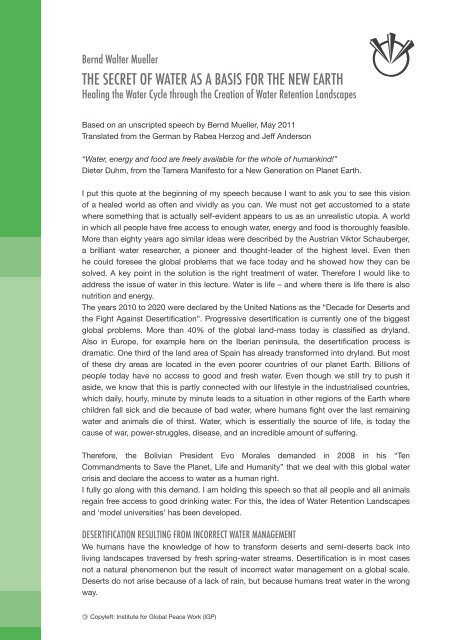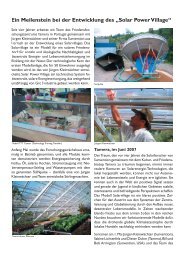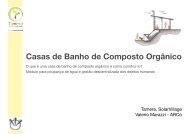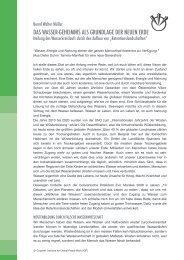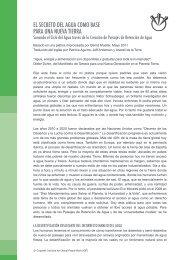You also want an ePaper? Increase the reach of your titles
YUMPU automatically turns print PDFs into web optimized ePapers that Google loves.
<strong>Bernd</strong> Walter <strong>Mueller</strong><br />
THE SECRET OF WATER AS A BASIS FOR THE NEW EARTH<br />
Healing the Water Cycle through the Creation of Water Retention Landscapes<br />
Based on an unscripted speech by <strong>Bernd</strong> <strong>Mueller</strong>, May 2011<br />
Translated from the German by Rabea Herzog and Jeff Anderson<br />
“Water, energy and food are freely available for the whole of humankind!”<br />
Dieter Duhm, from the <strong>Tamera</strong> Manifesto for a New Generation on Planet Earth.<br />
I put this quote at the beginning of my speech because I want to ask you to see this vision<br />
of a healed world as often and vividly as you can. We must not get accustomed to a state<br />
where something that is actually self-evident appears to us as an unrealistic utopia. A world<br />
in which all people have free access to enough water, energy and food is thoroughly feasible.<br />
More than eighty years ago similar ideas were described by the Austrian Viktor Schauberger,<br />
a brilliant water researcher, a pioneer and thought-leader of the highest level. Even then<br />
he could foresee the global problems that we face today and he showed how they can be<br />
solved. A key point in the solution is the right treatment of water. Therefore I would like to<br />
address the issue of water in this lecture. Water is life – and where there is life there is also<br />
nutrition and energy.<br />
The years 2010 to 2020 were declared by the United Nations as the “Decade for Deserts and<br />
the Fight Against Desertification”. Progressive desertification is currently one of the biggest<br />
global problems. More than 40% of the global land-mass today is classified as dryland.<br />
Also in Europe, for example here on the Iberian peninsula, the desertification process is<br />
dramatic. One third of the land area of Spain has already transformed into dryland. But most<br />
of these dry areas are located in the even poorer countries of our planet Earth. Billions of<br />
people today have no access to good and fresh water. Even though we still try to push it<br />
aside, we know that this is partly connected with our lifestyle in the industrialised countries,<br />
which daily, hourly, minute by minute leads to a situation in other regions of the Earth where<br />
children fall sick and die because of bad water, where humans fight over the last remaining<br />
water and animals die of thirst. Water, which is essentially the source of life, is today the<br />
cause of war, power-struggles, disease, and an incredible amount of suffering.<br />
Therefore, the Bolivian President Evo Morales demanded in 2008 in his “Ten<br />
Commandments to Save the Planet, Life and Humanity” that we deal with this global water<br />
crisis and declare the access to water as a human right.<br />
I fully go along with this demand. I am holding this speech so that all people and all animals<br />
regain free access to good drinking water. For this, the idea of Water Retention Landscapes<br />
and ‘model universities’ has been developed.<br />
DESERTIFICATION RESULTING FROM INCORRECT WATER MANAGEMENT<br />
We humans have the knowledge of how to transform deserts and semi-deserts back into<br />
living landscapes traversed by fresh spring-water streams. Desertification is in most cases<br />
not a natural phenomenon but the result of incorrect water management on a global scale.<br />
Deserts do not arise because of a lack of rain, but because humans treat water in the wrong<br />
way.<br />
©<br />
Copyleft: Institute for Global Peace Work (IGP)
One example: Our landscape, the Alentejo, is considered semi-arid. But in the last week<br />
there has been very heavy rain. The amount of rain that fell over a few days would have been<br />
enough to supply the whole population of this area with water for drinking and household<br />
use for one year. But instead it flowed away unused and in addition to that even caused<br />
damage: washing away the fertile soil, eroding the foundations of bridges, and flooding<br />
roads, villages and towns. People are now busy repairing the damage inflicted. This is costly<br />
and time-consuming, and with the next rain the same happens again, so they have no time<br />
to think about investing in new systems where they would have water all year round and<br />
could at the same time prevent floods.<br />
In Portugal we have a lot of rain in winter and in summer it is dry. Only a few decades<br />
ago Southern Portugal was a region where the streams flowed with water all year round,<br />
even in summer. Today the streams swell only during the rainy season and afterwards they<br />
become dry again. The system has fallen completely out of balance. This situation can be<br />
found worldwide, in according forms in all climate zones. Almost everywhere we can see<br />
widespread flooding and landslides with catastrophic consequences for humans, animals<br />
and nature. People then speak of natural disasters, but in reality they are man-made<br />
disasters.<br />
THE SMALL WATER CYCLE<br />
How can we change this situation locally and globally? What does system change mean in<br />
the case of water management and how can we initiate it? To find answers for this we have<br />
to look again at the actual state we nowadays find everywhere. It corresponds to the small<br />
(or ‘half’) water cycle as described by Viktor Schauberger: Water evaporates, forms clouds<br />
and precipitates. The rain strikes the ground which can no longer absorb the water because<br />
the forests have been cut down and the barren land used as pasture. The vegetation has<br />
been weakened through overgrazing and the topsoil has been washed away; the now<br />
unprotected ground warms up, but if the earth has a higher temperature than the rainwater it<br />
cannot absorb the rain, it closes itself, becomes hard and the water runs off. It accumulates<br />
in large streams which flow away quickly. Where there is still a layer of topsoil or loose fertile<br />
earth, it strips it away, thus leading to the fatal problem of erosion.<br />
The fast-flowing water quickly fills streams and rivers. In heavy rain they swell up and carry<br />
a lot of soil and other material with them, but they cannot deposit this at the next bend<br />
in the river because the water is no longer allowed to meander, as the rivers have been<br />
straightened and their banks additionally reinforced. The precious soil that is so urgently<br />
needed on the land now causes the rivers to silt-up downstream. They become shallow and<br />
breach their banks, leading to great damage especially in the cities lying at the river mouths.<br />
In the small water cycle we have rivers that no longer flow with clear spring-water but with<br />
muddy polluted rainwater. There are no places where the water has time to gather itself, to<br />
rest, to mature, and to enrich itself with minerals and information. When I look around here<br />
in this room and see all these young faces, I think that hardly any young person from Europe<br />
still knows streams that flow with clear spring-water.<br />
THE FALLING WATER TABLE<br />
If the water cannot sink into the earth-body, then it is lacking there. Due to this lack, the<br />
soil life suffers, the micro-organisms retreat, the fertility of the land decreases significantly,<br />
©<br />
Copyleft: Institute for Global Peace Work (IGP)
and fewer and fewer plant and animal species can survive. Soil dryness and the loss of<br />
biodiversity are the most important indicators of desertification.<br />
The water table is falling – worldwide and dramatically so. The global supply of drinking<br />
water is diminishing. Here we face the actuality directly leading us to apocalyptic scenarios<br />
if we do not manage to halt this process. Due to the falling water table, counter pressure<br />
can no longer be built up in the ground, salt water infiltrates unhindered deep into the land,<br />
and the soil and deeper lying freshwater reserves become saline. The ecosystem collapses<br />
– an almost irreversible situation. In many coastal areas worldwide this process is already<br />
happening. Also here in the Iberian peninsula many bore-holes and wells in the coastal areas<br />
have already become saline. But what kind of times does humanity approach if there is no<br />
more drinking water? Here we may not turn away and allow something to happen that could<br />
be prevented. The knowledge for this is available; now it is about applying it. We know: This<br />
is not how planet Earth is meant to be. This is not how the coexistence of humans, animals<br />
and Earth is meant to be. This is not how life is meant to be.<br />
THE LARGE WATER CYCLE<br />
Let us look again at the healthy picture – it is the picture of the large (or ‘full’) water cycle.<br />
The rain that falls on the earth is absorbed by a layer of humus that soaks it up like a<br />
sponge. Not long ago on the land of <strong>Tamera</strong> there was a living fertile soil layer of up to half<br />
a metre in depth. It was more or less like this over the whole of Portugal and in principle<br />
across the whole of Europe. This humus soil layer, which was shaded and rooted by plants,<br />
soaked up the rainwater and thus gave the water time to seep into the deeper ground layers<br />
and fill up the earth-body. In this way a saturated earth-body acted as a storage organ.<br />
There, underground, the water rests at different depths, sometimes over long periods of<br />
time. We still know little about what really happens to the water down there in the darkness.<br />
I feel this as the ‘female’ or ‘soul’ part of the water cycle. What we can say is that the water<br />
matures there by mineralising itself and taking on information. This ability to take on and<br />
store information is one of the essential and most mysterious qualities of water.<br />
At different depths in the saturated earth the water cools down differently. Where it is the<br />
coldest it rises back to the surface as mature spring-water. Spring-water has a great healing<br />
power for the Earth and all her creatures. Streams and rivers flowing with spring-water that<br />
are allowed to meander in accordance with their beings have healing power for the land. The<br />
water vitalises itself increasingly over the course of its flow. On the banks of such streams<br />
and rivers, diverse habitats develop where life unfolds itself.<br />
The water in the large water cycle is flowing continuously and steadily. The earth acts as<br />
a buffer, as it can absorb a large amount of water at once but releases it only slowly. In<br />
this way floods are prevented, and at the same time the streams carry water all year long.<br />
The balance is reached between the rainy winter months and the dry summer. This applies<br />
in principle throughout all climate zones. A large water cycle in which the earth-body<br />
completely fulfils its function once again creates stability and equilibrium everywhere.<br />
HEALING NATURE THROUGH WATER RETENTION LANDSCAPES<br />
Today the earth-body, the humus topsoil, has disappeared from a large percentage of the<br />
Earth’s surface. The erosion process, especially over the last decade, has progressed so<br />
rapidly and extensively that one can speak of a global disaster. This is why we must not<br />
delay ourselves by developing ecosystems which create a thin layer of humus only after<br />
thirty, forty or even more years. We need this balancing sponge-effect sooner. In order to<br />
©<br />
Copyleft: Institute for Global Peace Work (IGP)
complete the water cycle again we have to find a way in which the water can be absorbed<br />
by the earth despite the missing topsoil layer. This is how the idea of Water Retention<br />
Landscapes developed.<br />
Water Retention Landscapes are systems for the restoration of the full water cycle by<br />
retaining the water in the areas where it falls as rain. A Water Retention Landscape consists<br />
of a series of interconnected retention spaces, from pond-sized up to lake-sized, in which<br />
the rainwater can collect behind a dam constructed from natural material. The retention<br />
spaces themselves are not sealed with concrete or any artificial film, so that the water can<br />
slowly but steadily diffuse into the earth-body.<br />
The term ‘Water Retention Landscape’ is always connected with the concept of naturehealing.<br />
The construction of Water Retention Landscapes is an active and effective answer<br />
to the destruction of nature. In <strong>Tamera</strong> we have gained this knowledge from the Austrian<br />
permaculture specialist Sepp Holzer with whom we have been working together intensively<br />
for some years. There are no regions of human inhabitation unsuitable for the construction<br />
of Water Retention Landscapes. Wherever ecosystems have been destroyed or degraded,<br />
Water Retention Landscapes can and should be created, on every type of land, in every<br />
climate zone, on every hillside, and especially in areas with low precipitation as here they<br />
are particularly important. The less the amount of precipitation that falls in an area, and the<br />
greater the length of time between rainy periods, the more urgent the creation of a Water<br />
Retention Landscape becomes.<br />
But also in tropical high-rainfall regions Water Retention Landscapes will be a great step<br />
towards healing. They act in place of the fragile humus layer, which is sometimes washed<br />
away completely during only one rainy season after the clearance of the rainforests. And<br />
through their high water absorbing capacity they also help to prevent fatal landslides, which<br />
nowadays are caused more and more often by heavy rainfall. Thus they also directly save<br />
human lives.<br />
Perhaps there are still a few forested areas on Earth where it is not yet necessary to<br />
intervene because there is still enough humus. But, unfortunately, today these are only rare<br />
cases.<br />
Water Retention Landscapes are the healing impulse urgently required by the Earth and all<br />
her creatures. And they can and must arise in every place where people regain the courage,<br />
strength and also of course the knowledge needed to create them.<br />
For this we now need a common and determined power and direction. In order to create<br />
Water Retention Landscapes worldwide, special educational centres are required. We call<br />
them ‘model universities’. Here the knowledge of how Water Retention Landscapes function<br />
is taught in theory and practice. In this way a change-in-thinking process is initiated that<br />
naturally also includes all other aspects of human life. A Water Retention Landscape is<br />
sustainable only if the individual and social life is re-embedded into nature and the higher<br />
orders of creation.<br />
How such an embedding functions in modern times and which technological and social<br />
knowledge is needed for it – this all should be researched and taught in the models and be<br />
available for all people who seek this knowledge.<br />
The change-in-thinking process will ultimately only be completed when there is no longer a<br />
single living being on Earth lacking in water, nutrition and human compassion.<br />
©<br />
Copyleft: Institute for Global Peace Work (IGP)
GETTING TO KNOW THE BEING OF WATER<br />
The first step in the change of thinking begins with a new perception of water itself. A water<br />
retention space is not only to be understood technically but also exists in order to give an<br />
understanding of the being of water to a new kind of engineers. A water retention space has<br />
to be shaped in a way that the water does not stagnate, but on the contrary is able to move<br />
according to its being.<br />
Water is not only a physical or chemical substance that the human may deal with at his<br />
convenience or merely according to industrial norms. Water is a living being. We modern<br />
people have to learn to understand this all over again. The shaping of the water retention<br />
spaces is therefore not arbitrary. We observe water: How does it want to move? Which<br />
shapes of banks does it like? Which temperature and which differences in temperature does<br />
it like? Does it like to form waves or not? All of these aspects are incorporated into our work.<br />
As with every living being, water also needs to be allowed the freedom to move in<br />
accordance with its being. Water wants to roll, swirl, curve and meander – then it remains<br />
vital and fresh. By such movement it purifies itself, at the same time it also calms down and<br />
has time to seep into the earth-body.<br />
There are three important principles for the shaping of such water retention spaces:<br />
The longer side of the retention space is, if possible, laid out in the same direction as that of<br />
the prevailing wind. The wind then blows over a long surface thereby forming waves which<br />
oxygenate the water: oxygen is an important element for the purification of water. Wind and<br />
waves carry particles of debris to the shores where they are trapped by aquatic plants and<br />
eventually absorbed by them.<br />
Banks are never straightened or reinforced, but created in meandering forms with both steep<br />
and gently sloping parts so that the water can roll and swirl. At least one part of the shore is<br />
planted with aquatic and waterside plants.<br />
Deep and shallow zones are created. In this way different temperature zones emerge which<br />
provide healthy thermodynamics in the water. Shaded shore areas support this process.<br />
Thus the diversity of aquatic organisms finds its suitable habitats.<br />
The dam of a water retention space consists entirely of natural material: no artificial film<br />
or concrete is used. The vertical sealing layer of the dam consists of as fine a material as<br />
available – ideally clay – for which optimally the material excavated from the deep zones is<br />
used. It is connected to a watertight layer of subsoil that sometimes lies a few metres below<br />
the surface. The sealing layer is compacted and built-up layer by layer with fine, earth-moist<br />
material. Then it is piled up from both sides with mixed earth-material, covered with humus<br />
or topsoil, and can then be landscaped and planted on.<br />
Through this natural construction method the water retention spaces fit in with the<br />
landscape and do not become incongruous with their surroundings. After only a short time<br />
life reappears on the shores. Finally the plants, especially the trees, are once again provided<br />
with water from below as is appropriate to their nature. And we need rely less and less, and<br />
eventually not at all, upon artificial irrigation from above.<br />
THE HELPING FORCES<br />
In the construction of Water Retention Landscapes there is an abundance of helping<br />
forces from the kingdom of nature that stand by our side. Knowing this, the new engineers<br />
get in contact with these forces and ask them for their co-operation. There are millions<br />
©<br />
Copyleft: Institute for Global Peace Work (IGP)
upon millions of micro-organisms that immediately start their work the moment they<br />
notice that there is water even after the rainy season. They are our best co-workers. Most<br />
of them live invisibly in the earth. These beings sense that a sustainable healing process<br />
has been initiated here from which everything benefits. For a long time we might not see<br />
their effectiveness but we may know that they exist and quickly start their work. Eike<br />
Braunroth, an expert in the area of co-operation with nature, impressively describes in his<br />
book Harmonie mit den Naturwesen (“Harmony with Nature-Beings”) what happens when<br />
animals, previously considered as pests or vermin and fought against correspondingly, are<br />
finally recognised as co-operation partners. He writes about the example of slugs, aphids,<br />
voles, potato beetles and ticks:<br />
“Their plentiful occurrence, their rampant reproduction, their unstoppable eating orgies in my<br />
garden, their resistance against my tricks opened my senses to a different consciousness of<br />
life... Today they all live an unimpeded existence. They showed me what nature is capable of:<br />
unconditional friendship.”<br />
In our ecological work in <strong>Tamera</strong> this aspect of co-operation is strongly incorporated. Birds,<br />
for example, are necessary co-workers for afforestation, because some seeds need to pass<br />
through a bird’s stomach in order to germinate. Here lies a fascinating area of work and<br />
research.<br />
There are also helping forces still quite unfamiliar to us. Through Dhyani Ywahoo,<br />
a Cherokee spiritual teacher, we learned that lightning is an important factor in the<br />
revitalisation of weakened soil if it is again moist enough. In her book Voices of Our<br />
Ancestors: Cherokee Teachings from the Wisdom Fire she writes:<br />
“As those aquifers are depleted, the electrical energy of lightning has no place to be called<br />
to. The lightning activity is the pulse, just as the nervous system is the pulse that animates<br />
your body. So, as these aquifers are further depleted, there is less and less energy for<br />
growth, for life. There are also more subtle effects of the lightning.”<br />
Sepp Holzer has discovered that thunder is also a helping force for the growth of various<br />
species of edible mushrooms.<br />
We see with these examples how much exciting research work still lies in front of us.<br />
With the establishment of Water Retention Landscapes humankind re-enters the cooperation<br />
with the spirit of the Earth, and with the spirit of plants, animals and human beings<br />
that live or are meant to live in this space. In creating these systems it is not only about<br />
engineering but about the art of contact with the living and about the recognition that we<br />
humans are not the only beings living on this planet. Creation has been entrusted to us in<br />
order for us to perceive and care for it. This is the original role of humankind on Earth. Here<br />
the knowledge which in former times all indigenous people possessed is reawakened and<br />
transferred into modern life.<br />
THE WATER RETENTION LANDSCAPE OF TAMERA<br />
In <strong>Tamera</strong> we began in 2007 with the construction of the first water retention space.<br />
The proposal for it came from Sepp Holzer, who has supported us for a long time in the<br />
renaturalisation and healing of <strong>Tamera</strong>’s land. Until then we thought we lived in a dry country.<br />
When he showed us the dimensions of the first planned water retention space the question<br />
©<br />
Copyleft: Institute for Global Peace Work (IGP)
arose of how long it would take for such a large hole to fill up with water. ‘Lake 1’, as it is<br />
known today, is located in the centre of our site. The idea of having to watch over a dusty,<br />
half-empty pool for years did not motivate us to take this first step towards the planned<br />
Water Retention Landscape. Then, to make things clear to ourselves, we had the idea of<br />
calculating the average annual amount of precipitation falling upon the catchment area of the<br />
retention space. In our minds we filled this water into containers, each with a capacity of one<br />
cubic metre, and placed them one after the other in a row that reached a length spanning<br />
the almost one thousand kilometres from <strong>Tamera</strong> to Barcelona. That was enough to launch<br />
us out of the system of scarcity thinking.<br />
In the very same year we began with the construction. In the first winter the lake and the<br />
adjoining earth-body filled up a good two-thirds with water. After the second rainy season,<br />
which had below-average precipitation, only a few centimetres to the high-water level<br />
remained to be filled. In the third winter, so much rain fell that we could have filled several<br />
more retention spaces. Today, only four years after the construction began, it is as if there<br />
had never been anything other than a water retention space. Many people who visit <strong>Tamera</strong><br />
for the first time cannot believe at first that it is anything other than a natural lake. On the<br />
terraces by the shore we have created an edible landscape and planted thousands of fruit<br />
trees and shrubs. Wild animals such as the otter have settled here. And the birds have<br />
returned: we now have 93 different species of birds in <strong>Tamera</strong>, some of which are very rare<br />
species found only in water-rich areas. Already within the first year a new seepage spring<br />
arose which since then has flowed continuously throughout the year.<br />
The construction of Lake 1 was only the beginning. Since then we have created a number<br />
of further water retention spaces. In 2011 we want to start the construction of a water<br />
retention space with approximately three times the capacity of Lake 1. This will signify the<br />
breakthrough from a landscape with a lot of water to a Water Retention Landscape that<br />
will then be able to absorb the entire rainfall of an average winter. A number of additional<br />
springs will form and of course the water table will rise, or at least will fall no further. A water<br />
retention landscape is fully realised when no more rainwater leaves the land but rather<br />
all water flowing away comes from springs.<br />
This next large water retention space will be located on the highest part of our land, so<br />
the water pressure will be high enough to irrigate of all of the land as long as this is still<br />
necessary, without having to supply additional energy for pumping. With the water from<br />
this highest-situated retention space the water level of the subsequent retention spaces will<br />
remain almost stable all year round.<br />
Here in <strong>Tamera</strong> we want to demonstrate a model of how it could look everywhere in the<br />
Alentejo and basically everywhere in the world. Without water there is no life. Positively said:<br />
With water there is life. We are becoming ever more able to see and maintain the picture that<br />
is emerging in front of our eyes if we ask ourselves ‘how does it look if we live with water<br />
and not without water?’ How quickly we come to visions of paradise and how quickly we<br />
can step out of scarcity thinking on all levels! I would like to conclude with a quote from<br />
Viktor Schauberger. It comes from an essay he wrote in 1934, from the book Das Wesen des<br />
Wasser (“The Being of Water”):<br />
“From water everything originates. Therefore, water is the universal natural resource of<br />
every culture or the foundation of every physical or mental development. The unveiling<br />
of the secret of water will put an end to all manner of speculation or calculation and their<br />
©<br />
Copyleft: Institute for Global Peace Work (IGP)
excesses, to which belong war, hatred, envy, intolerance and discord of every kind. The<br />
thorough investigation of water therefore truly signifies the end of all monopolies, the end of<br />
all domination and the beginning of a socialism arising from the development of individualism<br />
in its most perfect form. If we succeed in unveiling the secret of water, in understanding<br />
how water can emerge, then it will become possible to produce all qualities of water at any<br />
location, and then one will be able to make vast areas of desert fertile; then the sale value<br />
of food and also that of machine power will fall so low that it will no longer be worthwhile to<br />
speculate with it.”<br />
I ask everyone to perceive this vision. I ask everyone to see how the human being is meant<br />
to be, to see the true standing of the human, and the role the creation of models plays in<br />
this. A person who takes his human rights back into his own hands also takes a stand once<br />
again for the rights of water, as demanded by Evo Morales, and will enter into co-operation<br />
with nature and its beings. When we have again found the inner picture of reconnection<br />
with nature then we begin to understand the sentence “Water, energy and food are freely<br />
available for the whole of humankind!”<br />
This is how life is meant to be.<br />
Thank you for listening.<br />
ABOUT THE AUTHOR:<br />
<strong>Bernd</strong> Walter <strong>Mueller</strong><br />
Born 1962 in Cologne, Germany.<br />
Nature researcher, specialist in the construction of Water Retention<br />
Landscapes, permaculturist, dowser.<br />
Since 2007, co-worker of the Peace Research Centre <strong>Tamera</strong> in<br />
Portugal, in close coopeation with Sepp Holzer. Today <strong>Bernd</strong> <strong>Mueller</strong> is<br />
director of the Ecology Department of <strong>Tamera</strong> and teacher of the Global<br />
Campus, an international training centre for peace workers.<br />
In 1986 he abandoned his engineering studies in the traditional university system because<br />
he did not find the answers he sought. He started his own business, ran a health food store,<br />
worked in landscape gardening and later in tree care.<br />
In 1989 he emigrated to Spain and managed an organic farm in the Sierra Nevada. There he<br />
found the necessary calmness to study natural processes through intense observation. He<br />
discovered a new, more sublte possibility of cooperation between man and nature.<br />
Today he transfers the insights from this process of self-education into the practical<br />
development of ecological models for landscape healing and the restoration of the Earth.<br />
©<br />
Copyleft: Institute for Global Peace Work (IGP)


